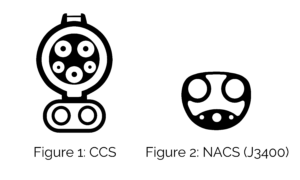Public charging access is growing by leaps and bounds, between expanded access to the Tesla Supercharger network and rapid deployment of new charging infrastructure. In the U.S., there is now a fast EV charging station for every 15 gas stations. Many chargers are coming online thanks to the National Electric Vehicle Infrastructure (NEVI) program passed through the Infrastructure, Investment, and Jobs Act. Installing ultra-fast EV charging stations can take longer than you might expect because there are a lot of parties and steps involved, so we’re thrilled to see new charging stations being deployed across the country.
You have probably heard that Tesla’s Supercharger network (Tesla’s name for its fast EV charging network) is starting to open to non-Tesla vehicles. Until recently, Tesla’s Supercharger network was only available for Tesla vehicles. Major automakers have committed to using the NACS, or J3400, charging standard. This means that all major automakers will be manufacturing their vehicles with the NACS/J3400 charging port. Some will be incorporating this port into new vehicles as early as next year (model year 2025).
For vehicles that don’t have a built-in NACS charging port (i.e. all non-Tesla EVs currently on the road like the Chevy Bolt or the Ford Mustang Mach-E), you can charge in one of two ways. You can charge at Tesla Superchargers that have the Magic Dock (built-in adaptor), or for EV drivers whose vehicles have the CCS charging port, you may be able to access additional charging stations by using an adapter. Auto manufacturers are working together to produce safe, qualified adapters to allow these vehicles to charge on the Supercharger Network. We should note that adapters only work at Tesla Superchargers that are version 3, a.k.a. V3, chargers or newer.

We’re excited to see these adapters reach drivers to allow them to charge more places. A few words of advice to ensure you stay safe while charging with an adapter:
- Only use an adapter that has been approved by your vehicle’s manufacturer, is approved for use by the charging network, and is UL 2252 certified.
- Most charging networks already restrict the use of unapproved/uncertified adapters through their terms and conditions.
- Your vehicle’s manufacturer and EV charging network providers (e.g. EVgo, etc.) are the best sources of information.
EV charging is safe, and with recent industry changes, it is more readily available than ever. Keep these tips in mind to continue to stay safe while charging your EV with an adapter.
If you’re interested in more on the changes to the Supercharger network and what that means for you and your vehicle, read this comprehensive article from Consumer Reports or check out Tesla’s info page on the process.


